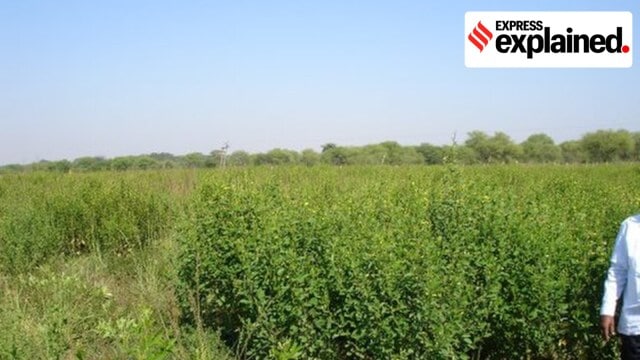To kick-start the Mission for Aatmanirbharta in Pulses from the ongoing rabi season — aimed at enhancing pulses production within the country and cutting out imports — the Ministry of Agriculture recently released operational guidelines.
Launched by Prime Minister Narendra Modi on October 11, the Mission for Aatmanirbharta in Pulses was announced by Finance Minister Nirmala Sitharaman in her Budget Speech on February 1. As outlined in the Finance Minister’s Budget Speech, the mission’s emphasis is on:

- Development and commercial availability of climate resilient seeds,
- Enhancing protein content,
- Increasing productivity,
- Improving post-harvest storage and management, and
- Assuring remunerative prices to the farmers.
The Mission will be implemented over a six-year period, from 2025-26 to 2030-31, with a financial outlay of Rs 11,440 crore. It aims to increase the total production of pulses in the country by 45 per cent– from 242 lakh metric tonnes in 2023-24 to 350 lakh metric tonnes in 2030-31. In the same period, it also aims at increasing the area under pulses by 13 per cent — from 275 lakh hectare to 310 lakh hectare, and improving the average yield by 28 per cent —from 881 kg/hectare to 1130 kg/hectare.
What is the current status of Pulses cultivation and production?
While different crops of pulses are cultivated across the country, Rajasthan accounted for the most (54.67 lakh hectare) of the total 275 lakh hectare area under pulses during 2023-24. It was followed by Madhya Pradesh (51 lakh hectare), Maharashtra (44 lakh hectare) and Uttar Pradesh (30 lakh hectare). In terms of pulses production, Madhya Pradesh (59.74 lakh metric tonnes) accounted for most of the total production of 242 lakh metric tonnes during 2023-24, followed by Maharashtra (40 lakh metric tonnes), Rajasthan (33 lakh metric tonnes) and Uttar Pradesh (31 lakh metric tonnes).
Half of the total area under pulses and over 60 per cent production was recorded during rabi season.
Gram, which is mostly grown in Maharashtra, Madhya Pradesh, Rajasthan, and Uttar Pradesh, accounts for the most area under pulses and also contributes most to the output. Moong is the second most grown pulses crop, cultivated mainly in Rajasthan and Madhya Pradesh. Tur, also known as arhar, is mainly grown in Karnataka, Maharashtra and Uttar Pradesh and is the third largest pulses crop in terms of area.
Story continues below this ad
Urad is mainly cultivated in Madhya Pradesh, Uttar Pradesh, Tamil Nadu and Maharashtra, while Masoor (lentil) is mainly grown in Madhya Pradesh and Uttar Pradesh.
Why is the mission significant?
India is the largest producer and consumer of pulses in the world. With demand exceeding domestic pulses production, the country is dependent on imports from countries like Myanmar, Mozambique, Tanzania, Australia and Canada. The import of pulses has increased in recent years.
As per the NITI Aayog’s report on “Strategies and Pathways for Accelerating Growth in Pulses towards the Goal of Atmanirbharta”, the demand for pulses in India is estimated to reach 268 lakh metric tonnes 2030 and 293 lakh metric tonnes by 2047.
To meet the rising demand, it is necessary to increase domestic production. India’s yield is lower than countries like Canada (2200 kg/hectare) and China (1815 kg/hectare). The mission thus aims to increase the yield to 1130 kg/hectare.
Story continues below this ad
Why is the mission focused on three pulses, tur, urad and masoor?
Currently, these three crops (tur, urad, masoor) cover around 34% of the total pulse cropped area and contribute significantly to the overall pulse production.
“However, there is a significant yield gap in these crops which needs to be addressed,” states the guidelines of the mission.
Of the proposed 35 lakh hectare area expansion under pulses, a maximum 9 lakh hectare is planned for tur, which will be in traditional states like Karnataka, Maharashtra, Uttar Pradesh, Gujarat, and Jharkhand, and non-traditional areas like Northeast region. The additional area under urad will be expanded by using rice fallows in Uttar Pradesh, Andhra Pradesh, and Maharashtra, while masoor will be promoted in rice fallow areas of West Bengal, Bihar, and Chhattisgarh.
Story continues below this ad
How is the new mission different from the Pulses component of the existing National Food Security and Nutrition Mission (NFSNM)?
According to the guidelines, the mission will subsume the pulses component of the NFSNM. The new mission has more interventions than the earlier programme. It also envisages a higher assistance of Rs 10,000 per hectare for Front Line Demonstrations (FLD) of improved agricultural technologies, as compared with Rs 9,000 per hectare in the earlier programme.
Besides, the mission also envisages 100 per cent procurement of three pulses–tur, masoor and urad — by National Agricultural Cooperative Marketing Federation of India (NAFED) and National Cooperative Consumers’ Federation (NCCF) under the Price Support Scheme (PSS) of the PM-AASHA.
“NAFED and NCCF will undertake 100% procurement of Tur, Urad, and Masoor for the next four years directly from farmers registered with these agencies and having formal agreements…Procurement of other pulses will continue as per PSS norms notified from time to time… Aadhaar-enabled biometric or facial authentication will be used to verify registered farmers,” states the mission guidelines.
How will the mission be implemented?
Story continues below this ad
According to the Union Ministry of Agriculture, the Mission will focus on a cluster-based approach to strengthen the agri value chain, from inputs to markets. “Each cluster will have at least 10 hectares of area, (2 hectares in case of hilly area and northeast region),” the guidelines state. The districts/clusters shall be identified from the potential pulses growing areas across states/UTs. While selecting the districts, emphasis will be given on:
- High Area-High Yield (HA-HY), High Area-Low Yield (HA-LY), Low Area-High Yield (LA-HY), and Low Area-Low Yield (LA-LY) district approach recommended by NITI Aayog
- Rice fallow, rainfed and watershed areas
- Districts mapped under Prime Minister Dhan-Dhaanya Krishi Yojana having potential for pulses cultivation
- Aspirational districts, Left Wing Extremism/ Border Area District
- Districts in which Adarsh Gram Yojana is being implemented
- North East, Himalayan, LWE, Island territories, and other backward areas
- Any other area approved by the State Steering Committee on Pulses
- Any other area notified by the Centre from time to time.








































